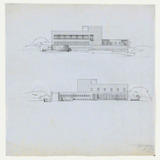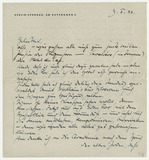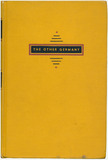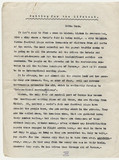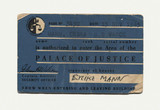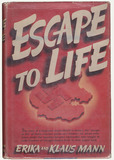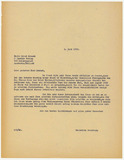Erich Mendelsohn: Design for the Schocken villa and library, Jerusalem
The architect Erich Mendelsohn had already worked for the successful businessman and art lover Salman Schocken a number of times: in the 1920s three of the Shocken company’s largest department stores – in Nuremberg, Stuttgart and Chemnitz – were built to his designs.
Erich Mendelsohn: Letter to his wife Luise on 3 February 1933
The extensive correspondence between Erich and Luise Mendelsohn (née Maas), almost all of which has survived, begins in 1910 shortly after their first meeting and ends with Mendelsohn’s death in 1953. The couple were geographically separated time and again – largely due to the successful architect’s professional obligations – and therefore reliant on written exchange.
Erika and Klaus Mann: The other Germany (1940)
After the success of their jointly published 1939 book Escape to Life, Erika and Klaus Mann swiftly began working on a follow-up project, which was issued by the New York publisher Modern Age Books in early 1940 under the title The Other Germany. Complementing their numerous lectures – educational talks about Germany, which they held across the USA – the siblings used their programmatically titled book to pursue the goal of convincing the Anglophone public of the existence of an “other Germany” beyond the Nazi regime.
Erika Mann: Reportage Waiting for the Lifeboat (1940)
At the end of August 1940 Erika Mann travelled via Lisbon to London. She accepted an offer from the British Minister of Information Duff Cooper to work on the BBC's German broadcasts as part of the broadcasting propaganda effort.
Erika Mann: Zehn Millionen Kinder (School for Barbarians), first edition (1938)
At the beginning of 1938 the New York publisher Modern Age Books released Erika Mann's first book in exile, the documentary report, School for Barbarians. The book was a study of methods of upbringing and education under the Nazis.
Erika Mann's identity card as a War Correspondent of the US Army (1944)
On 24 June 1943 Erika Mann received her first ID card from the War Department of the US Army as a news correspondent for the liberal weekly Liberty Magazine (New York) and the Toronto Star Weekly. Thus began a new chapter in her fight against the dictatorship of the Third Reich.
Erika Mann's pass for the international war crimes trials in Nuremberg (1945)
In mid-June 1945, one month after the end of the war, Erika Mann travelled for the last time in her capacity as a war correspondent to Europe. She remained until April 1946.
Erika und Klaus Mann: Escape to Life / Escape to Life. Deutsche Kultur im Exil (1939/1991)
After Klaus Mann had published a book with his one-year-elder sister Erika about their around-the-world trip in the late 1920s, the American publisher Houghton Mifflin offered the two close siblings another chance to work together on a book beginning in 1938.
Erna Adler: Photographs from Belgium (1937/38)
The photographer Erna Adler was a promising talent in the field of art portraiture in Vienna. In 1937 she had to start from the beginning again in exile in Belgium.
Ernst Krenek: Confirmation of a scholarship from the American Guild for German Cultural Freedom (1938)
On May 26, 1938, the board of the American Guild came together to decide on new applications for scholarships and extensions of scholarships. At this meeting, the composer Ernst Krenek was awarded the scholarship mentioned in the letter.
